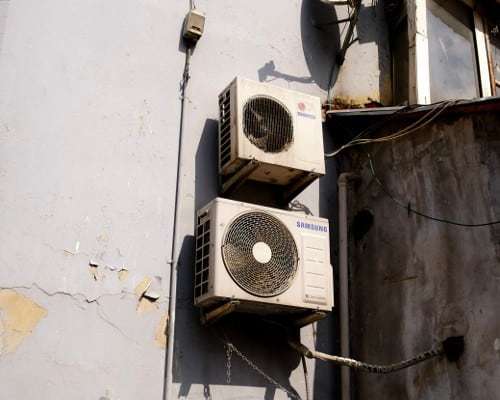We all know the importance of a comfortable home – it’s our sanctuary, our safe space. But achieving that comfort requires more than just cozy furniture and homey décor. It’s about the quality of our breathable air and the temperature. HVAC systems are a huge part of your home comfort.
Have you ever found yourself wondering about the efficiency of your HVAC system? Well, don’t fret – we have you covered.
This post will help explain complex terms like AFUE and SEER to make it easier to understand. We’ll explore what these acronyms mean and why they should matter to you.
What is HVAC efficiency? SEER vs. AFUE
HVAC efficiency means how adeptly your heating, ventilation and air conditioning system uses an energy source – like electricity or gas – to heat or cool your household. A more energy-efficient HVAC system will use less power, cutting utility and energy use costs.
Two measurements stand out as particularly important when it comes to HVAC efficiency: Seasonal Energy Efficiency Ratio (SEER) and Annual Fuel Utilization Efficiency (AFUE).
- AFUE furnace rating is a measure of a furnace’s heating efficiency. A higher AFUE percentage means a more efficient furnace.
- SEER, on the other hand, measures the total cooling output (in a season of use), divided by the electric energy input over the same timeframe. Similarly, a higher SEER rating means better energy efficiency.
Understanding these ratings will help you choose an energy-saving, environmentally-friendly HVAC system. The team at River Valley Air Conditioning is always available to guide you in the right direction for your home. If you need some help, just give us a call!
AFUE: The foundation of furnace efficiency
Annual Fuel Utilization Efficiency is an efficiency measure mainly used for furnaces of all types (oil, gas, and electric). Expressed as a percentage figure, AFUE shows you what portion of your fuel goes towards heating your home as opposed to being wasted.
How is AFUE calculated?
To calculate AFUE, simply divide the total heat output of the furnace by the total energy consumed by the furnace. As such, an AFUE rating of 80% means that 80% of the energy from fuel has been converted to heat during combustion, with 20% lost during this process.
Why would you want a high AFUE furnace rating?
A high AFUE rating indicates a high-efficiency furnace. As a homeowner – this means reducing wasted energy and heating costs. An 80% AFUE furnace converts 80% of energy from fuel into heat, while 95% AFUE furnaces convert 95% of it. So, the higher the AFUE, the less you spend on heating your home.
How can you improve your furnace’s AFUE rating?
Fortunately, your system’s efficiency isn’t always set in stone. You can give it a boost through regular maintenance by installing a programmable thermostat and replacing older, inefficient models with newer, high-efficiency models.
To keep your furnace running at its best, regular maintenance is critical – neglect can lead to reduced performance and lower AFUE furnace ratings even on highly efficient systems.
SEER: The gauge of cooling efficiency
Seasonal Energy Efficiency Ratio (SEER) is an efficiency measurement for cooling systems, including central air conditioners and heat pumps. Like the AFUE rating for furnaces, the SEER rating is a percentage. However, SEER represents the amount of cooling your system will deliver per unit of energy consumed. Higher SEER ratings mean greater energy efficiency.
How is SEER calculated?
To calculate a unit’s SEER rating, one must divide the cooling output over a typical cooling season by the overall electric energy input during the same timeframe.
Here’s an example:
An AC unit uses 1,200 watts of electricity to produce 10,000 BTUs (British Thermal Units) of heat per hour. To calculate its SEER rating, we divide the number of BTUs by the number of watts used – in this case, it’s 10,000 BTUs by 1,200 watts, which equals 8.33.
This is averaged over the period of the entire cooling season to calculate the unit’s SEER rating.
Note: the higher the SEER rating is, the more energy-efficient it is.
Why do you want a high rating?
A high SEER rating implies a more efficient air conditioner or heat pump. Energy savings come in the form of reduced energy usage and bills. Switching from an older air conditioner with a low rating to one with a higher SEER rating can save you a lot of money in cooling expenses.
How can you improve your system’s SEER rating?
An practical approach to increasing your cooling system’s SEER rating can include regular maintenance, switching over to a programmable thermostat and replacing old inefficient units with modern high-efficiency models.
Regular cleanings and professional tune-ups help your home system to operate at peak efficiency – it can even improve its SEER rating as a result.
Financial and environmental benefits
High-efficiency HVAC systems are often more expensive upfront. That said, the long-term benefits on your wallet and the environment often outweigh these initial expenses.
Financial benefits
- Reduced energy bills: HVAC systems with high AFUE and SEER ratings utilize less energy to cool or heat your home, resulting in lower energy bills.
- Long-term savings: Despite the initial purchase cost, the efficiency reduces the amount of money you’ll spend on your utility bills.
- Potential rebates: Many local utility companies also provide rebates or incentives for homeowners who install high-efficiency systems, which can add to your savings.
Environmental benefits
- Lower carbon footprint: High-efficiency systems consume less energy, leading to lower greenhouse gas emissions. With less need for fossil fuels, these systems help to preserve our natural resources.
- Reduced strain on the electrical grid: Cutting energy usage saves you money and reduces the pressure on the electrical grid.
Need help choosing your next system? Contact River Valley!
If you need help choosing an upgraded HVAC system for your home, you know who to call. River Valley Air Conditioning is dedicated to equipping you with the knowledge and support to maximize your home’s heating and cooling efficiency. Understanding what AFUE vs SEER ratings are is an important first step, but don’t worry – we are here for guidance in all aspects of HVAC ownership.
If you need to upgrade your old system, install a new unit, or just need advice on your current maintenance habits, we’re here for you. Contact us today!

